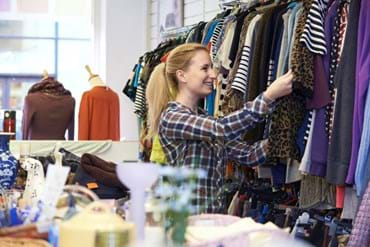The first mouthful of mildly musty air might tickle your throat. The thought of trying on a random person’s used and discarded clothes (even their owner doesn’t want them anymore) may seem a little disconcerting. But to some, the idea of thrusting one’s self into a cluster of cast offs or rummaging through reams of rejects is pure bliss.

Discovering unique (and occasionally antique) pieces for a fraction of the original retail price can be delightfully fulfilling for the seasoned second hand shopper. Vintage clothing shopping also supports a circular economy, bolsters income for local charities and small businesses and supports individuals selling their own unwanted clothes. It is an easy way to actively be involved in recycling/reusing and gives the buyer access to a wide array of styles from countless eras.
If you needed any more reason to venture into vintage a new study from the University of Tasmania indicates buying second hand could also mean you are more stylish! The study revealed those surveyed who considered themselves ‘style conscious’ were more likely to shop second hand. The results revealed that style consciousness was a bigger reason for people to shop second hand, even ahead of being frugal or ecologically conscious (thought these are of course additional benefits). Being stylish is not the same as fashion forward. The term ‘fashion’ tends to refer to the newest look, which is constantly changing and requires frequent wardrobe updates to maintain. While ‘style’ is more of an inbuilt personal expression and individual identity with mainstream trends being ignored over the desire to seek out authentic and original pieces which then become wardrobe staples for years to come.
According to a recent sustainability report on fashion resale in Australia by Reluv 72% of Australians purchased at least one item of second hand clothing in the financial year 2020-2021. Meanwhile James Reinhart, CEO of online second-hand fashion retailer Thredup, has predicted the global second-hand market will double in the next five years to A$102 billion.
 While the ‘fast fashion’ industry is currently creating 92 million tonnes of waste per year and using 79 trillion litres of water, only 15% of these clothes are recycled or reused. Circular fashion (the resale of used clothes) is a promising avenue to keep used clothes in circulation instead of being sent to landfill as well as reducing carbon emissions used to make new clothes. It is also important to note that if your clothes are very cheap then the person who sewed them did not get paid very well. Worker exploitation is unfortunately the only way fast fashion can thrive.
While the ‘fast fashion’ industry is currently creating 92 million tonnes of waste per year and using 79 trillion litres of water, only 15% of these clothes are recycled or reused. Circular fashion (the resale of used clothes) is a promising avenue to keep used clothes in circulation instead of being sent to landfill as well as reducing carbon emissions used to make new clothes. It is also important to note that if your clothes are very cheap then the person who sewed them did not get paid very well. Worker exploitation is unfortunately the only way fast fashion can thrive.
To make your second hand clothing choices as long lasting and sustainable as possible opt for natural fibres such as linen, cotton or wool. Synthetic fibres make up a large portion of new clothes and are manufactured using petrochemicals and plastic fibres making them unbiodegradable. They are also often manufactured quickly and don’t last for long. Unfortunately these fabrics are cheaper to produce than natural fibres but the long term cost on the environment is much higher. Avoid buying new or second hand clothing items made from the following synthetic fibres to help reduce the demand for these fabrics: polyester, nylon, acrylic and elastane.
If you needed any more encouragement, here are some other good reasons to check out your local vintage trader for some new threads:
- Book Week, Halloween, Easter bonnet parades, or any low budget dramatic production requiring a costume will benefit from some frugal foraging in an op shop for a unique and fairly priced outfit.
- You’re a little short on cash but could really do with updating your wardrobe with a piece or two.
- You particularly like eclectic or classic fashion pieces and actively seek them out
- You are artsy crafty and have the know how to create new things out of old things (double thumbs up for resourcefulness and creativity) ie. make a new skirt out of a retro curtain or fashion a brooch out of a broken earring.
- You can experiment with a new style without the expense of buying a whole new wardrobe. No big loss if you decide the look doesn’t suit you, just send it back from whence it came.
- It is easier to emotionally detach from second hand pieces as they don’t cost a third of your week’s salary. So when it comes time to let it go you can more easily pass it on, making decluttering easier.
- Vintage is the new new!
Every tiny choice we make as individual consumers has a broader impact on the collective. If we can begin to educate ourselves about how our clothes are made we can then make more conscious decisions about where to source them. When buying new seek out locally made ethical brands ideally in natural fibres and classic styles which will outlive any fad or passing trend. These will certainly be more expensive than Kmart or Target but they will have been crafted with care and are likely to last for many years. Like all consumer purchases, consider this, if we spend more on good quality items we are more likely to look after them and cherish them. Seek to only have a wardrobe of high quality clothes which make you feel good about yourself so you are less likely to bolster your esteem with low quality impulse buys. Less really IS more in the case of a well curated classic wardrobe. Keep it simple and stylish and it will stand the test of time.

Alison Gallagher is a freelance writer, resourcefulness expert and entrepreneur. She has been featured in various publications including Stellar Magazine, Australian Health and Fitness Magazine, and Cleo Magazine. Alison is particularly passionate about sharing practical tips on how to live simply, sustainably and seasonally.






